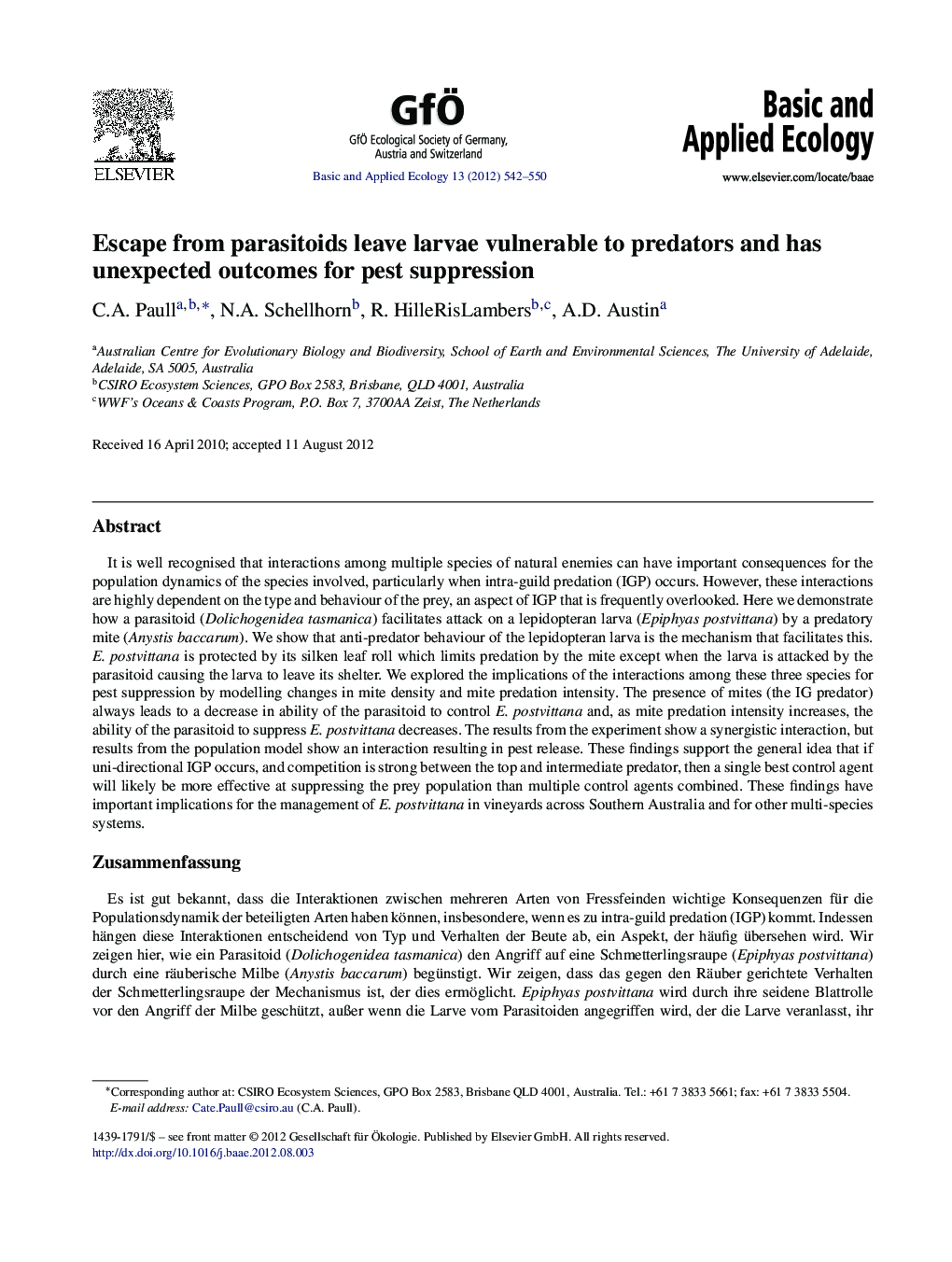| کد مقاله | کد نشریه | سال انتشار | مقاله انگلیسی | نسخه تمام متن |
|---|---|---|---|---|
| 4384048 | 1304385 | 2012 | 9 صفحه PDF | دانلود رایگان |

It is well recognised that interactions among multiple species of natural enemies can have important consequences for the population dynamics of the species involved, particularly when intra-guild predation (IGP) occurs. However, these interactions are highly dependent on the type and behaviour of the prey, an aspect of IGP that is frequently overlooked. Here we demonstrate how a parasitoid (Dolichogenidea tasmanica) facilitates attack on a lepidopteran larva (Epiphyas postvittana) by a predatory mite (Anystis baccarum). We show that anti-predator behaviour of the lepidopteran larva is the mechanism that facilitates this. E. postvittana is protected by its silken leaf roll which limits predation by the mite except when the larva is attacked by the parasitoid causing the larva to leave its shelter. We explored the implications of the interactions among these three species for pest suppression by modelling changes in mite density and mite predation intensity. The presence of mites (the IG predator) always leads to a decrease in ability of the parasitoid to control E. postvittana and, as mite predation intensity increases, the ability of the parasitoid to suppress E. postvittana decreases. The results from the experiment show a synergistic interaction, but results from the population model show an interaction resulting in pest release. These findings support the general idea that if uni-directional IGP occurs, and competition is strong between the top and intermediate predator, then a single best control agent will likely be more effective at suppressing the prey population than multiple control agents combined. These findings have important implications for the management of E. postvittana in vineyards across Southern Australia and for other multi-species systems.
ZusammenfassungEs ist gut bekannt, dass die Interaktionen zwischen mehreren Arten von Fressfeinden wichtige Konsequenzen für die Populationsdynamik der beteiligten Arten haben können, insbesondere, wenn es zu intra-guild predation (IGP) kommt. Indessen hängen diese Interaktionen entscheidend von Typ und Verhalten der Beute ab, ein Aspekt, der häufig übersehen wird. Wir zeigen hier, wie ein Parasitoid (Dolichogenidea tasmanica) den Angriff auf eine Schmetterlingsraupe (Epiphyas postvittana) durch eine räuberische Milbe (Anystis baccarum) begünstigt. Wir zeigen, dass das gegen den Räuber gerichtete Verhalten der Schmetterlingsraupe der Mechanismus ist, der dies ermöglicht. Epiphyas postvittana wird durch ihre seidene Blattrolle vor den Angriff der Milbe geschützt, außer wenn die Larve vom Parasitoiden angegriffen wird, der die Larve veranlasst, ihr Refugium zu verlassen. Wir erkundeten die Folgen der Interaktionen zwischen diesen drei Arten für die Schädlingskontrolle indem wir Änderungen in der Milbendichte und des Räuberdrucks durch die Milbe modellierten. Die Anwesenheit der Milben mindert stets die Fähigkeit des Parasitoiden E. postvittana zu kontrollieren. Mit steigendem Räuberdruck durch die Milbe, sinkt die Fähigkeit des Parasitoiden zur Kontrolle. Die experimentellen Ergebnisse zeigten eine synergistische Interaktion, aber die Ergebnisse des Populationsmodels zeigen eine Interaktion, die zu einer Entlastung des Schädlings führt. Diese Befunde unterstützen den Gedanken, dass, wenn einseitige IGP stattfindet und die Konkurrenz zwischen dem Spitzenräuber und dem untergeordneten Räuber stark ist, ein einziger bester Kontrollagent die Beutepopulation vermutlich effektiver kontrollieren wird als mehrere Kontrollagenten zusammen. Diese Befunde haben wichtige Implikationen für das Management von E. postvittana in Weinbergen in ganz Süd-Australien und für andere Mehr-Arten-Systeme.
Journal: Basic and Applied Ecology - Volume 13, Issue 6, September 2012, Pages 542–550